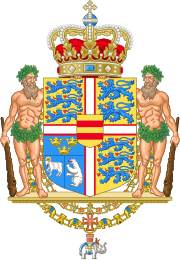
A | B | C | D | E | F | G | H | CH | I | J | K | L | M | N | O | P | Q | R | S | T | U | V | W | X | Y | Z | 0 | 1 | 2 | 3 | 4 | 5 | 6 | 7 | 8 | 9
| ||||||||||||||||||||||||||||||||||||||||||||||||||||||||||||||||||||||||||||||||||||||
All 179 seats in the Folketing 90 seats needed for a majority | ||||||||||||||||||||||||||||||||||||||||||||||||||||||||||||||||||||||||||||||||||||||
This lists parties that won seats. See the complete results below.
| ||||||||||||||||||||||||||||||||||||||||||||||||||||||||||||||||||||||||||||||||||||||
 |
|---|

General elections were held in Denmark on 15 September 2011 to elect the 179 members of the Folketing. Of those 179, 175 members were elected in Denmark, two in the Faroe Islands and two in Greenland.
The incumbent centre-right coalition led by Venstre lost power to a centre-left coalition led by the Social Democrats making Helle Thorning-Schmidt the country's first female Prime Minister. The Social Liberal Party and the Socialist People's Party became part of the three-party government. The new parliament convened on 4 October, the first Tuesday of the month.
Background
Anders Fogh Rasmussen, who had been re-elected Prime Minister following the 2007 parliamentary election, resigned on 5 April 2009 to become the Secretary General of NATO in August. Polls indicated a preference for early elections over simply having Finance Minister Lars Løkke Rasmussen take over as PM; the Social Democrats' Helle Thorning-Schmidt was also suggested as the preferred candidate for PM.[1] However, Pia Kjærsgaard, the leader of the Danish People's Party, had reiterated the DPP's continued support for the government, previously avoiding a new election and making Rasmussen the PM within the existing parliament.[2] However, when Rasmussen resigned that support became moot.
Date
According to the Danish Constitution, the election had to take place no later than 12 November 2011 since the last Danish election was held on 13 November 2007. The prime minister can call the election at any date, provided it is no later than four years from the previous election. Danish media and political commentators speculated about the timing of the election since Rasmussen took office as Prime Minister in April 2009. The election was called on 26 August 2011, after heavy media speculation.[citation needed]
MPs not seeking re-election
The following had as of March 2010 announced that they would not seek re-election.[3]
- Malou Aamund (Venstre)
- Britta Schall Holberg (Venstre)
- Preben Rudiengaard (Venstre)
- Jens Vibjerg (Venstre)
- Jens Kirk (Venstre)
- Lone Møller (Social Democrats)
- Vibeke Grave (Social Democrats)
- Niels Sindal (Social Democrats)
- Lise von Seelen (Social Democrats)
- Jens Christian Lund (Social Democrats)
- Jens Peter Vernersen (Social Democrats)
- Søren Krarup (Danish People's Party)
- Jesper Langballe (Danish People's Party)
- Lone Dybkjær (Social Liberal Party)
- Niels Helveg Petersen (Social Liberal Party)
- Bente Dahl (Social Liberal Party)
- Jørgen Poulsen (Social Liberal Party)
- Line Barfod (Red-Green Alliance)
Retired MPs
This section needs additional citations for verification. (October 2011) |
- Mogens Camre (DF)
- Rikke Hvilshøj (V)
- Gitte Seeberg (Independent)
- Mia Falkenberg (DF)
- Anders Fogh Rasmussen (V)
- Morten Messerschmidt (DF)
- Bendt Bendtsen (K)
- Svend Auken (S)
- Morten Helveg Petersen (R)
- Thomas Adelskov (S)
- Lene Hansen (S)
- Knud Kristensen (K)
- Connie Hedegaard (K)
- Søren Gade (V)
Contesting parties
Coalitions
The former Prime Minister, Lars Løkke Rasmussen, led a centre-right minority government consisting of the Liberal Party and the Conservative People's Party. This coalition government worked with regular parliamentary support from the national conservative Danish People's Party and often gained the necessary 90th seat for a majority in the Folketing through negotiations with the sole MP from the Christian Democrats Ørum-Jørgensen[4] and independent MP Christmas Møller, both elected in 2007 as conservative MPs and since having defected.
Since the 2007 election, the Liberal Alliance (previously Ny Alliance) had gained momentum in opinion polls, and since early 2010, the governing coalition had not been able to gather a majority in the polls without the support of the Alliance. The continuing rise in the polls was to an extent the result of the internal crisis in the Conservative People's Party over the leadership Lene Espersen[5] and the continuing debate over a lack of true liberal/conservative ideology in government policy.[6]
On 13 January, the continuing turmoil within the Conservative group in the Folketing caused Lene Espersen to resign as political leader of the party and focus on her role as Minister of Foreign Affairs.[7] A leadership election between Brian Mikkelsen, the Minister of Economic and Business Affairs and Lars Barfoed, the Justice Minister, was widely expected,[8] but on 14 January the Conservative group in the Folketing unanimously elected Barfoed as their new political leader. He was formally elected as chairman of the party at a party convention within a few weeks.[9]
The Social Democrats, under the leadership of Helle Thorning-Schmidt, had enjoyed continuing majorities in opinion polls since late 2009 and hoped to form a centre-left government coalition consisting of the Socialist People's Party and the Social Liberal Party with parliamentary support from the small Red-Green Alliance.[10][11]
Both Margrethe Vestager (Social Liberal Party) and Villy Søvndal (Socialist People's Party) pledged their support to Thorning-Schmidt before the election.[12] But there has been considerable debate about the future politics of this coalition, mainly because the Social Liberal Party demands a more liberal economic agenda. Also on immigration issues there are political differences between the three coalition parties. This led some observers to believe that the Social Liberal Party would not join a government coalition but instead opt to be a part of the parliamentary support of a new, centre-left government.[13] In the event the Social Liberals did join the new three-party coalition government formed on 3 October.



